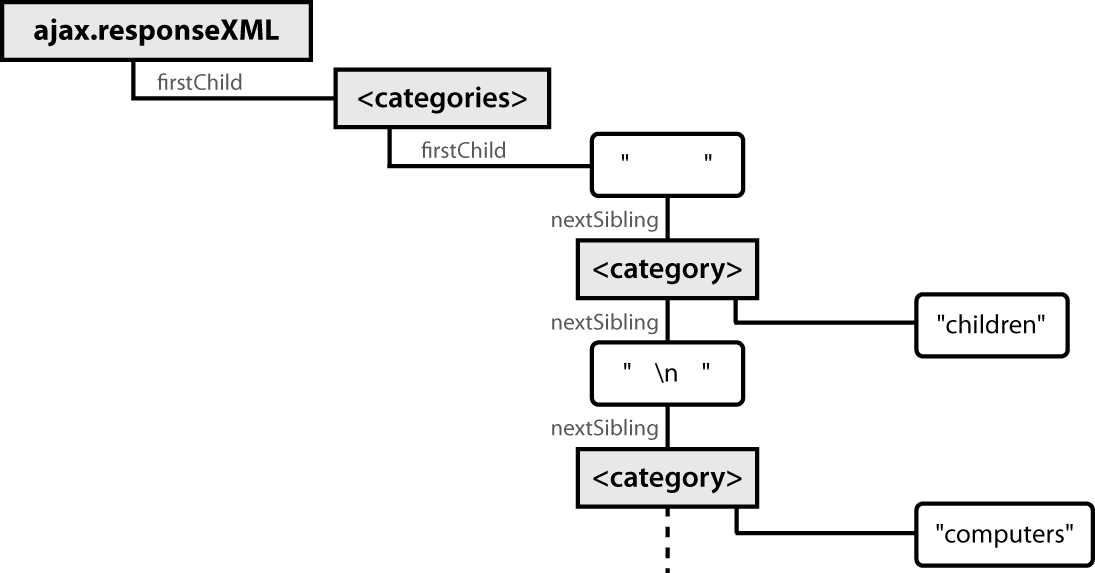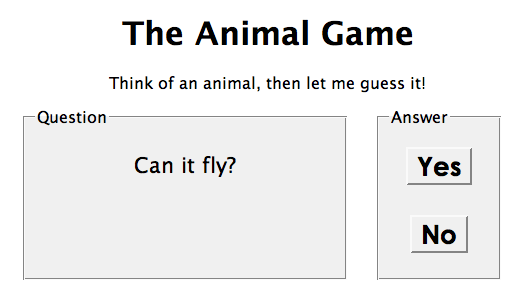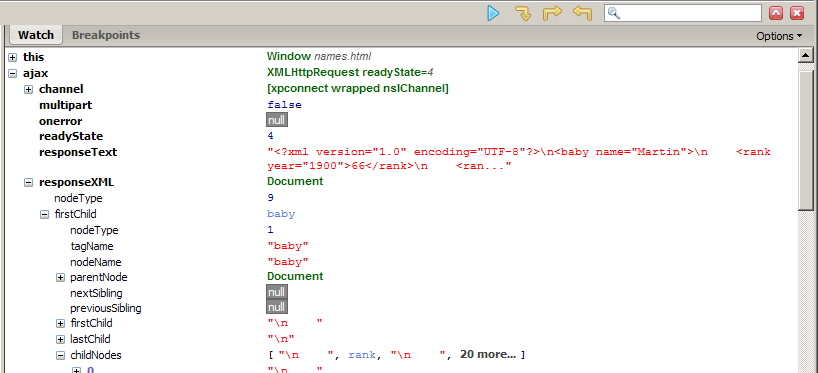Web Programming Step by Step
Lecture 19
XML
Reading: 10.3 - 10.4
Except where otherwise noted, the contents of this presentation are Copyright 2010 Marty Stepp and Jessica Miller.
The bad way to store Aja data
My note: BEGIN TO: Tove FROM: Jani SUBJECT: Reminder MESSAGE (english): Hey there, Don't forget to call me this weekend! END
- we could send a file like this from the server to browser with Ajax
- what's wrong with this approach?
What is XML?
- XML: a "skeleton" for creating markup languages
- you already know it!
- syntax is identical to XHTML's:
<element attribute="value">content</element>
- syntax is identical to XHTML's:
- languages written in XML specify:
- names of tags in XHTML:
h1,div,img, etc. - names of attributes in XHTML:
id/class,src,href, etc. - rules about how they go together in XHTML: inline vs. block-level elements
- names of tags in XHTML:
- used to present complex data in human-readable form
- "self-describing data"
Anatomy of an XML file
<?xml version="1.0" encoding="UTF-8"?> <!-- XML prolog --> <note> <!-- root element --> <to>Tove</to> <from>Jani</from> <!-- element ("tag") --> <subject>Reminder</subject> <!-- content of element --> <message language="english"> <!-- attribute and its value --> Don't forget me this weekend! </message> </note>
- begins with an
<?xml ... ?>header tag ("prolog") - has a single root element (in this case,
note) - tag, attribute, and comment syntax is just like XHTML
Uses of XML
- XML data comes from many sources on the web:
- web servers store data as XML files
- databases sometimes return query results as XML
- web services use XML to communicate
- XML is the de facto universal format for exchange of data
- XML languages are used for music, math, vector graphics
- popular use: RSS for news feeds & podcasts
Pros and cons of XML
- pro:
- easy to read (for humans and computers)
- standard format makes automation easy
- don't have to "reinvent the wheel" for storing new types of data
- international, platform-independent, open/free standard
- can represent almost any general kind of data (record, list, tree)
-
con:
- bulky syntax/structure makes files large; can decrease performance
- example: quadratic formula in MathML
- can be hard to "shoehorn" data into a good XML format
- bulky syntax/structure makes files large; can decrease performance
What tags are legal in XML?
- any tags you want!
- examples:
- an email message might use tags called
to,from,subject - a library might use tags called
book,title,author
- an email message might use tags called
- when designing an XML file, you choose the tags and attributes that best represent the data
- rule of thumb: data = tag, metadata = attribute
Doctypes and Schemas
- "rule books" for individual flavors of XML
- list which tags and attributes are valid in that language, and how they can be used together
- used to validate XML files to make sure they follow the rules of that "flavor"
- the W3C HTML validator uses the XHTML doctype to validate your HTML
- for more info:
- Document Type Definition (DTD) ("doctype")
- W3C XML Schema
- optional — if you don't have one, there are no rules beyond having well-formed XML syntax
- (we won't cover these any further here)
XML and Ajax

- web browsers can display XML files, but often you instead want to fetch one and analyze its data
-
the XML data is fetched, processed, and displayed using Ajax
- (XML is the "X" in "Ajax")
- It would be very clunky to examine a complex XML structure as just a giant string!
- luckily, the browser can break apart (parse) XML data into a set of objects
- there is an XML DOM, very similar to the (X)HTML DOM
XML DOM tree structure

<?xml version="1.0" encoding="UTF-8"?> <categories> <category>children</category> <category>computers</category> ... </categories>
- the XML tags have a tree structure
- DOM nodes have parents, children, and siblings
Recall: Javascript XML (XHTML) DOM
The DOM properties and methods* we already know can be used on XML nodes:
- properties:
firstChild,lastChild,childNodes,nextSibling,previousSibling,parentNodenodeName,nodeType,nodeValue,attributes
- methods:
appendChild,insertBefore,removeChild,replaceChildgetElementsByTagName,getAttribute,hasAttributes,hasChildNodes
- caution: cannot use HTML-specific properties like
innerHTMLin the XML DOM!
* (though not Prototype's, such as up, down, ancestors, childElements, or siblings)
Navigating the node tree
- caution: can only use standard DOM methods/properties in XML DOM (NOT Prototype's)
-
caution: can't use
ids orclasses to use to get specific nodes (no$or$$). Instead:// returns all child tags inside node that use the given element var elms = node.getElementsByTagName("tagName"); -
caution: can't use
innerHTMLto get the text inside a node. Instead:var text = node.firstChild.nodeValue;
-
caution: can't use
.attributeNameto get an attribute's value from a node. Instead:var attrValue = node.getAttribute("attrName");
Using XML data in a web page
- use Ajax to fetch data
- use DOM methods to examine XML:
XMLnode.getElementsByTagName("tag")
- extract the data we need from the XML:
XMLelement.getAttribute("name"),XMLelement.firstChild.nodeValue, etc.
- create new HTML nodes and populate with extracted data:
document.createElement("tag"),HTMLelement.innerHTML
- inject newly-created HTML nodes into page
HTMLelement.appendChild(element)
Fetching XML using AJAX (template)
new Ajax.Request("url",
{
method: "get",
onSuccess: functionName
}
);
...
function functionName(ajax) {
do something with ajax.responseXML;
}
ajax.responseTextcontains the XML data in plain textajax.responseXMLis a pre-parsed XML DOM object
Analyzing a fetched XML file using DOM
<?xml version="1.0" encoding="UTF-8"?> <employees> <lawyer money="5"/> <janitor name="Sue"><vacuumcleaner/></janitor> <janitor name="Bill">too poor</janitor> </employees>
We can use DOM properties and methods on ajax.responseXML:
// zeroth element of array of length 1 var employeesTag = ajax.responseXML.getElementsByTagName("employees")[0]; // how much money does the lawyer make? var lawyerTag = employeesTag.getElementsByTagName("lawyer")[0]; var salary = lawyerTag.getAttribute("money"); // "5" // array of 2 janitors var janitorTags = employeesTag.getElementsByTagName("janitor"); var excuse = janitorTags[1].firstChild.nodeValue; // " too poor "
Analyzing a fetched XML file using DOM (2)
<?xml version="1.0" encoding="UTF-8"?> <employees> <lawyer money="5"/> <janitor name="Bill"><vacuumcleaner/></janitor> <janitor name="Sue">too poor</janitor> </employees>
What are the results of the following expressions?
// zeroth element of array of length 1
var employeesTag = ajax.responseXML.getElementsByTagName("employees")[0];
-
employeesTag.firstChild -
ajax.responseXML.getElementsByTagName("lawyer") -
employeesTag.getElementsByTagName("janitor").length -
employeesTag.getElementsByTagName("janitor")[0].firstChild -
employeesTag.getElementsByTagName("janitor")[1].firstChild -
employeesTag.getElementsByTagName("janitor")[0].nextSibling
Larger XML file example
<?xml version="1.0" encoding="UTF-8"?> <bookstore> <book category="cooking"> <title lang="en">Everyday Italian</title> <author>Giada De Laurentiis</author> <year>2005</year><price>30.00</price> </book> <book category="computers"> <title lang="en">XQuery Kick Start</title> <author>James McGovern</author> <year>2003</year><price>49.99</price> </book> <book category="children"> <title lang="en">Harry Potter</title> <author>J K. Rowling</author> <year>2005</year><price>29.99</price> </book> <book category="computers"> <title lang="en">Learning XML</title> <author>Erik T. Ray</author> <year>2003</year><price>39.95</price> </book> </bookstore>
Navigating node tree example
// make a paragraph for each book about computers var books = ajax.responseXML.getElementsByTagName("book"); for (var i = 0; i < books.length; i++) { var category = books[i].getAttribute("category"); if (category == "computers") { // extract data from XML var title = books[i].getElementsByTagName("title")[0].firstChild.nodeValue; var author = books[i].getElementsByTagName("author")[0].firstChild.nodeValue; // make an XHTML <p> tag containing data from XML var p = document.createElement("p"); p.innerHTML = title + ", by " + author; document.body.appendChild(p); } }
Exercise: Late day distribution
- Write a program that shows how many students turn homework in late for each assignment.
- Data service here:
http://webster.cs.washington.edu/cse190m/hw/hw.php- parameter:
assignment=hwN
- parameter:
A historical interlude: why XHTML?
- in XML, different "flavors" can be combined in single document
- theoretical benefit of including other XML data in XHTML
- nobody does this
- most embedded data are in non-XML formats (e.g., Flash)
- non-XML data must be embedded another way (we'll talk about this later on)
- requires browser/plugin support for other "flavor" of XML
- development slow to nonexistent
- most XML flavors are specialized uses
Exercise: Animal game
- Write a program that guesses which animal the user is thinking of. The program will arrive at a guess based on the user's responses to yes or no questions. The questions come from a web app named
animalgame.php.

Practice problem: Animal game (cont'd)
- The data comes in the following format:
<node nodeid="id"> <question>question</question> <yes nodeid="id" /> <no nodeid="id" /> </node>
<node nodeid="id"> <answer>answer</answer> </node>
- to get a node with a given id:
animalgame.php?nodeid=id - start by requesting the node with
nodeidof1to get the first question
Attacking the problem
Questions we should ask ourselves:
- How do I retrieve data from the web app? (what URL, etc.)
- Once I retrieve a piece of data, what should I do with it?
- When the user clicks "Yes", what should I do?
- When the user clicks "No", what should I do?
- How do I know when the game is over? What should I do in this case?
Debugging responseXML in Firebug

- can examine the entire XML document, its node/tree structure

